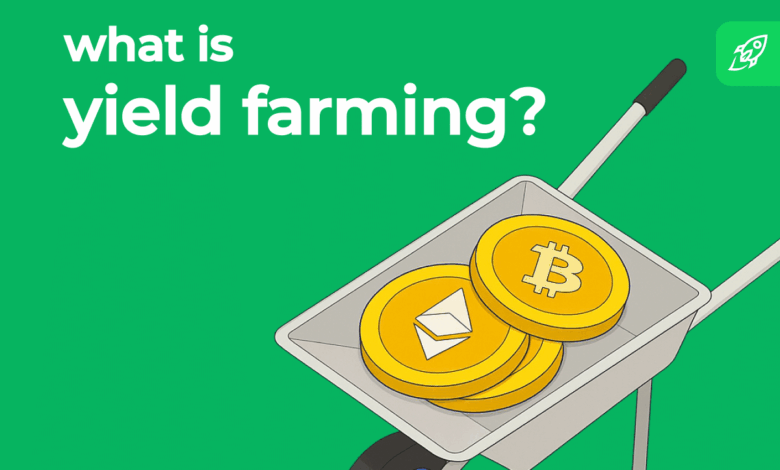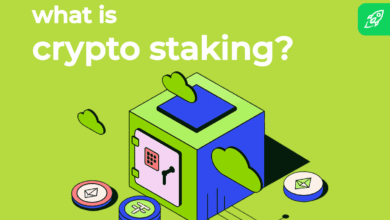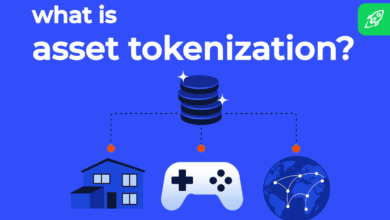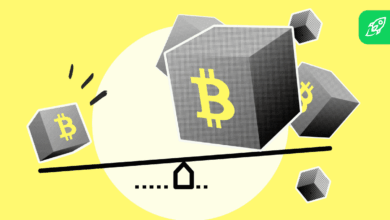What Is Yield Farming in Crypto? A Beginner’s Guide to DeFi Income

For years, crypto investors have been looking for ways to do more than just hold their assets—and yield farming has become one of the most popular strategies. It offers higher potential returns than regular investments, but also comes with high-stakes risks. If you’re thinking about trying yield farming, it’s important to understand how it works and what to watch out for. This guide breaks it down clearly, so you can decide if it’s the right move for you.
What Is Yield Farming?
Yield farming is a way to earn rewards by putting your cryptocurrency to work. You deposit tokens into a decentralized finance (DeFi) protocol, and in return, you get interest or extra tokens. It’s like earning interest on a savings account—but instead of a bank, it’s a smart contract holding your funds.
Read more: DeFi vs. CeFi.
Think of yield farming like renting out a spare room. Your crypto is the room. When you’re not using it, you let others borrow it. In return, they pay you rent (which is your yield).
How Does Yield Farming Work?
Yield farming works by locking your cryptocurrency into smart contracts on decentralized platforms. These smart contracts form liquidity pools. Other users borrow from or trade against these pools, and you earn a portion of the fees or interest they generate.
Here’s how the process works:
- Choose a platform. You select a DeFi protocol like Uniswap, Compound, or Yearn Finance.
- Deposit funds. You deposit tokens into a liquidity pool. This could be a pair like ETH/USDC or a single token like DAI.
- Receive rewards. In exchange, you earn some yield. This can come from trading fees, interest from borrowers, or incentive tokens given by the platform.
Many platforms also use liquidity mining, where you earn governance tokens (e.g., UNI, SUSHI) in addition to your standard yield.
How Much Can You Earn From Yield Farming?
The yield varies. It depends on the platform, token pair, market demand, and level of risk.
- Low-risk strategies (like stablecoin lending) often offer 2–10% APY.
- Higher-risk pools can reach 50–200% APY or more, but these usually involve volatile token pairs or newer platforms.
Always check if the return is APR (Annual Percentage Rate) or APY (Annual Percentage Yield). APY includes compounding; APR does not.
Example:
A USDC/ETH pair on Uniswap might offer a 15% annual yield, including trading fees and token rewards. A newer protocol offering its native token as an incentive might advertise 150% APY—but the token price could crash, wiping out those gains.
Common Types of Yield Farming
Yield farmers use different methods to earn rewards from their crypto. These methods vary in terms of risk, reward, and complexity. Each one involves interacting with DeFi yield farming protocols to generate passive income.
Liquidity Providing
Liquidity providers (LPs) deposit token pairs into decentralized exchanges (DEXs) like Uniswap or Curve. These tokens power trades on the platform. In return, LPs earn a share of the trading fees and sometimes bonus tokens.
Example: You add ETH and USDC to a Uniswap pool. Each time someone swaps between them, you get a small cut of the fee. Some pools also offer extra yield farming rewards paid in governance tokens.
Staking
Staking involves locking tokens in a smart contract to support a blockchain or DeFi platform. You earn rewards for securing the network or participating in governance.
Example: You stake SOL in the Solana network or stake CAKE on PancakeSwap. In both cases, you earn crypto yield-farming rewards over time, often paid in the platform’s native token.
Lending
Lending platforms like Compound and Aave let you lend your crypto to borrowers. Yield farmers earn interest on their deposits, often with additional token incentives.
Example: You deposit DAI into Aave. Borrowers pay interest, and you receive a part of it. Aave may also reward you with extra tokens like stkAAVE.
Yield Farming vs. Staking: What’s the Difference?
Staking is one way to farm yield—but not all yield farming is staking. They are both ways to earn passive income in crypto, but they work differently and each comes with its own risks. Yield farming is a broader, more active strategy that can involve lending, providing liquidity, and chasing rewards across multiple platforms. Staking, on the other hand, usually means locking up tokens to support a blockchain and earn steady rewards.
Here is an overview of the key differences between the two.
| Feature | Yield Farming | Staking |
| Definition | Broad strategy to earn rewards via DeFi | Locking tokens to support a network or protocol |
| Includes | Staking, providing liquidity, lending | Only staking |
| Complexity | High—often involves multiple platforms | Low—set it up and forget it |
| Rewards | Interest, trading fees, bonus tokens | Fixed/token-based rewards |
| Risk Level | Higher—smart contract risks, volatility | Lower—but may include lock-up or slashing |
| Flexibility | Often requires active management | Mostly passive |
Read more: Yield Farming vs. Staking.
Popular Yield Farming Strategies
Yield farming isn’t just about picking a platform, it’s about how you use it. The most successful yield farmers apply strategies that balance risk, maximize returns, and adapt to changing market conditions. Instead of relying on a single protocol, they optimize across multiple DeFi yield-farming platforms, chase incentives, and use tools to automate and protect their gains.
1. Yield Optimization Across Protocols
Yield farmers monitor multiple DeFi platforms and move funds where rewards are highest. Tools like Yearn or DeFi Llama help track APY and shift assets automatically, reducing the need for manual reallocation.
2. Multi-Layer Incentives Farming
This strategy involves selecting pools that offer stacked rewards: base interest, trading fees, and governance tokens. Farmers often target new platforms with aggressive token emissions to maximize short-term gains—all while understanding the higher risk.
3. Impermanent Loss Minimization
To avoid volatility risk, some liquidity providers choose stablecoin-only pools (e.g., USDC/DAI) or use protocols with built-in impermanent loss protection, such as Bancor or Thorchain.
4. Looping for Leverage
Advanced users borrow against supplied assets to re-deposit them and increase exposure. This looping boosts returns but increases liquidation risk. It’s often used with stablecoins to reduce the risk of price fluctuations.
5. Auto-Compounding Strategies
Yield farmers use vaults or aggregators that reinvest rewards automatically. This compounds gains over time. Platforms like Beefy and Autofarm simplify this process, though they add an extra layer of smart contract risk.
Stay Safe in the Crypto World
Learn how to spot scams and protect your crypto with our free checklist.

Yield Farming Risks
Yield farming offers high rewards, but it comes with serious risks. Unlike traditional financial instruments, DeFi protocols rely on smart contracts, volatile digital assets, and market incentives that can change quickly. Every step in the yield farming process—from choosing a liquidity pool to collecting rewards—comes with trade-offs.
Volatility
Most yield farming involves volatile digital assets. Prices can swing sharply, affecting the value of your holdings. A sudden drop in token value can wipe out your gains, especially when farming with newer or low-liquidity tokens. Unlike stable traditional investments, crypto assets are highly reactive to news, regulation, and market sentiment.
Impermanent Loss
Liquidity providers on automated market makers (AMMs) like Uniswap or SushiSwap are exposed to impermanent loss. This occurs when the value of the tokens in a pool changes relative to each other. When you withdraw, your share of the pool might be worth less than if you had simply held the tokens. This risk grows with asset volatility.
Rug Pulls
Rug pulls are among the most dangerous risks of yield farming. In a rug pull, developers of a DeFi protocol remove liquidity or exploit the smart contract to steal user funds. These scams are common in unaudited or newly-launched platforms. Always verify whether a protocol has been audited and check its track record before depositing any funds.
Liquidity Pools Drying Up
Liquidity pools depend on participation. If liquidity providers withdraw, the pool shrinks, slippage increases, and yields drop. This can make it hard to exit a position without losing value. Pools offering unusually high rewards often attract temporary capital, which can vanish quickly once incentives are reduced or market conditions shift.
Most Popular Yield Farming Protocols
Here are the leading platforms used by yield farmers. Each protocol offers different features, reward structures, and levels of risk.
- Uniswap. A decentralized exchange (DEX) using automated market maker (AMM) technology. It allows users to provide liquidity and earn a share of the transaction fees.
- Curve Finance. A DEX optimized for stablecoin trading and low-slippage swaps. Yield farmers can earn fees and CRV tokens by providing liquidity.
- Yearn Finance. An aggregator that moves user funds across DeFi protocols for the best yield. Uses vaults to auto-compound rewards.
- PancakeSwap. The leading DEX on BNB Chain. Offers liquidity pools, staking, and lottery features. Uses CAKE as its reward token.
- Convex Finance. Built on top of Curve to maximize CRV earnings without locking CRV tokens. Attracts users who want boosted rewards with less complexity.
How to Start Yield Farming: Step-by-Step
Getting started with yield farming may seem hard, especially if you’ve never done anything like it before. But once you understand the process, it’s just smooth sailing ahead––and in reality, it’s really not that complex.

1. Choose Your Blockchain and Wallet
First, select the blockchain network you’ll use—Ethereum, BNB Chain, Arbitrum, or others. Then, set up a compatible wallet such as MetaMask or Trust Wallet. This wallet connects you to the DeFi ecosystem and stores your digital assets securely.
2. Fund Your Wallet
Buy or transfer the tokens you want to farm with. You’ll typically need a pair of tokens (e.g., ETH and USDC) for liquidity provision, plus some native tokens (like ETH or BNB) to pay transaction fees.
3. Pick a DeFi Platform
Choose a trusted, decentralized trading platform or lending protocol. Uniswap, Aave, Curve, and PancakeSwap are some of the most popular options for yield farming. Always check audits, total value locked (TVL), and community reputation before using a platform.
4. Provide Liquidity or Stake Tokens
Follow the platform’s instructions to contribute liquidity. This may involve depositing a token pair into a liquidity pool or staking a single token. Once confirmed, you’ll receive LP (liquidity provider) tokens or staking confirmation.
5. Start Earning Yield
Your assets will now earn rewards—transaction fees, interest, or bonus tokens—depending on the protocol. These rewards accumulate over time and can often be claimed manually.
6. Monitor Your Position
The yield farming process requires active monitoring. Keep an eye on reward rates, pool performance, and market volatility. If incentives drop or liquidity dries up, you may want to move your funds.
7. Withdraw and Reinvest or Cash Out
You can withdraw your funds at any time, unless the platform has a lock-in period. Consider reinvesting your rewards to compound gains, or converting them back into stablecoins or fiat, depending on your strategy.
Is Yield Farming Profitable in 2025?
Yes, yield farming can still be profitable in 2025—especially when compared to traditional financial instruments. The returns often exceed what you’d get from savings accounts or government bonds, and the strategy continues to support decentralized money markets while generating real passive income through liquidity protocols.
That said, it’s not as lucrative as it once was. Since the beginning of 2025, token incentives have dropped, and competition among liquidity providers has increased. This makes high-yield opportunities harder to find and more short-lived.
Profitability now depends on a smart strategy. You need to manage risk, track platform performance, and often rely on automation tools to stay competitive. If you’re willing to stay active and informed, yield farming can still deliver strong returns.
Final Thoughts: Is Yield Farming Right for You?
Yield farming offers the potential for high returns, especially compared to traditional financial instruments. But those gains come with real risks—market volatility, smart contract flaws, and platform instability. Whether you’re looking to generate passive income or diversify your crypto portfolio, yield farming can be a valuable tool if approached with caution, research, and a clear strategy. Start small, choose trusted protocols, and stay engaged with the evolving DeFi ecosystem.
FAQ
Is yield farming taxable?
Yes, yield farming is taxable in most countries. Earnings from staking, lending, or liquidity provision are typically considered income, while selling or swapping tokens may trigger capital gains.
What is the average return on yield farming?
Average returns vary by protocol and risk level. Stablecoin pools often yield 5–15% APY, while riskier strategies can exceed 25% APY. However, remember that these returns are never guaranteed and depend on market conditions and platform incentives.
What are the best tools and platforms for yield farming?
Many DeFi protocols support yield farming, including Uniswap, Aave, Curve, and Yearn Finance. Tools like DeFi Llama, Zapper, and Beefy Finance help you track yield, manage assets, and automate strategies across multiple platforms.
What is the market cap of yield farming?
The total value locked (TVL) across major yield farming protocols exceeded $10 billion in early 2025––a far cry from the over $20B in 2022, but still a respectable value nonetheless. It also has a higher peak and a lower low than the TVL in 2024 and 2023.
Is yield farming safe for beginners?
Yes and no. While some platforms offer beginner-friendly options, it’s not risk-free. Start small, use audited protocols, and learn the mechanics before scaling your investment strategy.
How much money do I need to start yield farming?
You can start with as little as $50–$100, but small amounts may be eroded by transaction fees, especially on networks like Ethereum. Using low-fee blockchains like BNB Chain or Arbitrum makes it easier to start farming with less capital.
Can I lose all my funds while yield farming?
Yes, you can lose all your funds if the protocol gets hacked, if there’s a rug pull, or if your tokens lose value. These are known risks of yield farming. Always assess platform security and avoid unaudited or suspicious projects.
What’s the difference between APR and APY in yield farming?
APR (Annual Percentage Rate) shows simple interest without compounding. APY (Annual Percentage Yield) includes the effect of compounding over time.
Disclaimer: Please note that the contents of this article are not financial or investing advice. The information provided in this article is the author’s opinion only and should not be considered as offering trading or investing recommendations. We do not make any warranties about the completeness, reliability and accuracy of this information. The cryptocurrency market suffers from high volatility and occasional arbitrary movements. Any investor, trader, or regular crypto users should research multiple viewpoints and be familiar with all local regulations before committing to an investment.





